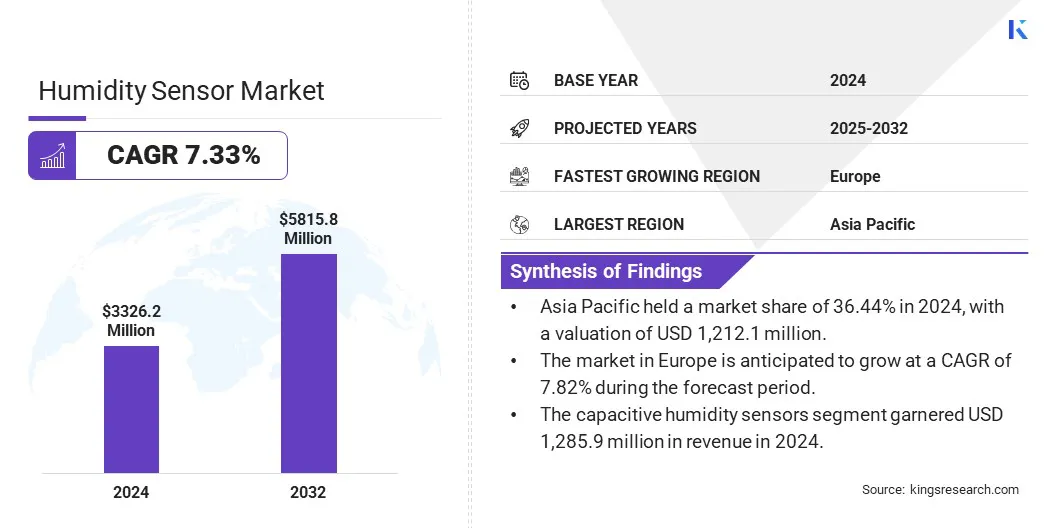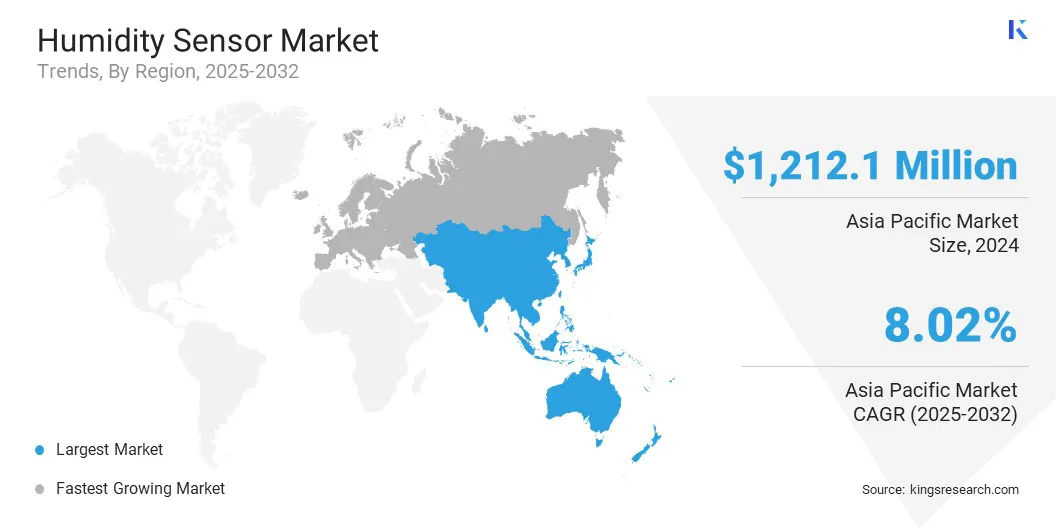Market Definition
The market encompasses the development, production, and distribution of devices that detect and measure moisture levels in the air. This market includes capacitive, resistive, and thermal conductivity sensors, integrated modules, and related calibration & maintenance services.
It serves sectors such as automotive, HVAC, healthcare, agriculture, and industrial automation. The market's scope covers both analog and digital sensors used in environmental monitoring, process control, and smart device applications. The report provides a comprehensive analysis of key drivers, emerging trends, and the competitive landscape expected to influence the market over the forecast period.
Humidity Sensor Market Overview
The global humidity sensor market size was valued at USD 3,326.2 million in 2024 and is projected to grow from USD 3,544.4 million in 2025 to USD 5,815.8 million by 2032, exhibiting a CAGR of 7.33% during the forecast period.
Rising HVAC adoption and industrial digital transformation drive the market by enabling precise climate control, energy efficiency, real-time monitoring, predictive maintenance, and smart IoT integration across diverse sectors.
Key Market Highlights:
- The humidity sensor market size was valued at USD 3,326.2 million in 2024.
- The market is projected to grow at a CAGR of 7.33% from 2025 to 2032.
- Asia Pacific held a market share of 36.44% in 2024, with a valuation of USD 1,212.1 million.
- The capacitive humidity sensors segment garnered USD 1,285.9 million in revenue in 2024.
- The industrial segment is expected to reach USD 2,306.7 million by 2032.
- The market in Europe is anticipated to grow at a CAGR of 7.82% during the forecast period.
Major companies operating in the humidity sensor industry are IST AG, dol-sensors A/S, OMEGA Engineering inc., Mifa Systems Pvt Ltd., Honeywell International Inc, amphenol, Texas Instruments Incorporated., Sensirion AG, TE Connectivity., Siemens, Teracom Ltd, Bosch Sensortec GmbH, Schneider Electric, Renesas Electronics Corporation., and Pyrotron (India) Inc.

The rapid expansion of consumer electronics is significantly accelerating the demand for humidity sensors. Integration of smart sensors in smartphones, wearable devices, and home automation systems is driving their large-scale adoption.
Manufacturers prioritize compact, energy-efficient, and high-performance sensor solutions to enhance user experience. This surge in connected technologies is creating sustained opportunities for humidity sensor innovation and commercialization across global markets.
Rising Adoption of Heating, Ventilation, and Air Conditioning (HVAC) Systems
Rising adoption of HVAC systems across residential, commercial, and industrial sectors significantly propels the market. Enhanced climate control requirements, energy efficiency regulations, and increasing emphasis on indoor air quality drive the integration of advanced humidity sensing technologies.
These sensors enable precise monitoring and regulation, optimizing system performance while reducing operational costs, thereby fostering sustained market expansion.
- In April 2025, the India Brand Equity Foundation reported a significant increase in the air conditioner (AC) market, driven by record heat waves and rising temperature forecasts. Blue Star Ltd. expected summer sales to grow by 30%, with the strongest growth coming from smaller cities where AC use in hospitals, malls, and restaurants is becoming more common. Rapid urbanization and poor ventilation in crowded housing are driving demand higher. The International Energy Agency projects market volume to rise from 93 million units in 2024 to 240 million units by 2030.
Supply Chain Disruptions and Raw Material Shortages Impacting Production and Costs
The humidity sensor market is constrained by supply chain disruptions and raw material shortages, impacting production timelines and cost structures. Fluctuations in the availability of key components such as semiconductor materials and specialized polymers have led to increased lead times and pricing volatility.
Manufacturers are diversifying their supplier base, investing in local sourcing, and adopting agile manufacturing practices. Furthermore, strategic inventory management and advanced forecasting techniques are being implemented to enhance supply chain resilience, ensuring consistent product delivery and maintaining competitive positioning in a volatile global market.
Industrial digital transformation in this market demands advanced, real-time environmental monitoring for enhanced operational efficiency. Integration of smart sensors with IoT platforms enables predictive maintenance, process optimization, and regulatory compliance.
Growing adoption across manufacturing, automotive, and energy sectors further accelerates the market expansion, positioning humidity sensors as critical components in connected, data-driven industrial ecosystems.
- In January 2024, Emerson introduced the AVENTICS DS1 dew point sensor, an industrial device that simultaneously monitors dew point, temperature, humidity, and compressed air quality in real time. The DS1 allows for early detection and prevention of excess moisture, protecting equipment from damage. By improving air quality, it enhances process control, prolongs pneumatic component lifespan, ensures regulatory compliance, and minimizes maintenance & unplanned downtime.
Humidity Sensor Market Report Snapshot
|
Segmentation
|
Details
|
|
By Type
|
Capacitive Humidity Sensors, Resistive Humidity Sensors, Thermal Conductivity Humidity Sensors
|
|
By End Use
|
Automotive, Pharmaceutical & Healthcare, Industrial, Building Automation & Domestic Appliances
|
|
By Region
|
North America: U.S., Canada, Mexico
|
|
Europe: France, UK, Spain, Germany, Italy, Russia, Rest of Europe
|
|
Asia-Pacific: China, Japan, India, Australia, ASEAN, South Korea, Rest of Asia-Pacific
|
|
Middle East & Africa: Turkey, U.A.E., Saudi Arabia, South Africa, Rest of Middle East & Africa
|
|
South America: Brazil, Argentina, Rest of South America
|
Market Segmentation:
- By Type (Capacitive Humidity Sensors, Resistive Humidity Sensors, Thermal Conductivity Humidity Sensors): The capacitive humidity sensors segment earned USD 1,285.9 million in 2024, due to their high accuracy, low power consumption, wide operating range, and cost-effectiveness, making them the preferred choice across various industries.
- By End Use (Automotive, Pharmaceutical & Healthcare, Industrial, and Building Automation & Domestic Appliances): The automotive segment held 37.44% share of the market in 2024, due to the increasing demand for advanced climate control, safety systems, and enhanced passenger comfort in vehicles.
Humidity Sensor Market Regional Analysis
Based on region, the global market has been classified into North America, Europe, Asia Pacific, Middle East & Africa, and South America.

Asia Pacific accounted for 36.44% share of the humidity sensor market in 2024, with a valuation of USD 1,212.1 million. The dominance is attributed to rapid industrial growth, high production capacity in electronics, and increasing integration of sensor technologies in consumer devices & automotive systems.
Strong demand from end-user industries, coupled with government initiatives promoting smart infrastructure and environmental monitoring, accelerates adoption. Additionally, the presence of major OEMs and a robust supply chain enhances market competitiveness, reinforcing the region's leading position in the global landscape.
The humidity sensor industry in Europe is poised for significant growth at a robust CAGR of 7.82% over the forecast period. This growth is attributed to the rising demand for precision agriculture and climate-controlled farming. The increasing adoption of advanced agricultural technologies to enhance crop yield and optimize resource usage significantly contributes to sensor deployment.
Moreover, supportive government policies and funding for sustainable farming practices further accelerate market growth, positioning the region as a key contributor to the market.
Regulatory Frameworks
- In India, the Bureau of Indian Standards (BIS) regulates quality and safety standards for electronic products. Humidity sensors used in consumer electronics, industrial controls, and automotive applications require BIS certification under relevant IS/IEC measurement and control standards.
- In Europe, CE marking is mandatory for electronic products, including humidity sensors, under key EU directives like LVD, EMC, RED, and the Machinery Directive, ensuring compliance with safety, electromagnetic compatibility, and proper functioning across the European market.
Competitive Landscape
The humidity sensor industry is characterized by frequent product launches and technological advancements from leading companies. These players focus on introducing high-precision, durable sensors tailored for applications in IoT and industrial automation.
The market also registers an expansion of product portfolios and strategic collaborations aimed at strengthening competitive positioning. This dynamic environment reflects efforts to address evolving demands across diverse end-use sectors.
- In April 2024, Sentinum introduced its latest innovation, a temperature and humidity sensor that supports both Mioty and LoRa, powered by Epishine’s cutting-edge organic indoor solar cells. The partnership between Sentinum and Epishine signifies a key advancement in sensor technology, delivering a sustainable, maintenance-free alternative to traditional battery-operated devices.
Key Companies in Humidity Sensor Market:
- IST AG
- dol-sensors A/S
- OMEGA Engineering inc.
- Mifa Systems Pvt Ltd.
- Honeywell International Inc
- amphenol
- Texas Instruments Incorporated.
- Sensirion AG
- TE Connectivity.
- Siemens
- Teracom Ltd,
- Bosch Sensortec GmbH
- Schneider Electric
- Renesas Electronics Corporation.
- Pyrotron (India) Inc.
Recent Developments (Product Launches)
- In October 2024, Sensirion launched its most cost-effective temperature sensor. The STS4L, the newest addition to Sensirion’s STS4x temperature sensor series, was designed specifically for applications where cost and space were critical. With tailored accuracy specifications, it delivered excellent performance along with industry-leading delivery times.
- In August 2024, AVTECH Software (AVTECH) announced the introduction of its advanced Digital Particulate & Temperature Sensor. Developed for integration with AVTECH’s Room Alert monitoring systems, this sensor delivers a comprehensive solution for real-time monitoring of airborne particulate matter (PM) and temperature, supporting enhanced indoor air quality (IAQ) management and occupant well-being. The Room Alert platform continuously monitors critical environmental parameters such as temperature, humidity, flood, power, smoke, and more.


